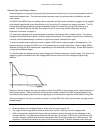
Tsunami MP.11 Antenna Installation
Copyright © 2006 Proxim Wireless Corporation. All rights reserved. 24
Maximum Range
The maximum range of your system is based upon:
• The type of outdoor antenna equipment
• The data speed of the wireless link
• The clearance of the signal path (see “Clearance Factor” below).
The values in this section are based upon calculations that assume optimal radio conditions. They do not
represent a guarantee that the same maximum distance can be achieved at your location. Differences in
performance figures can result from:
• Incorrect alignment of antennas (see “Aligning the Antenna” on page 19)
• Polarization mismatch of the antennas
• Sources of interference or unexpected reflections in the signal path that affect the communications quality
(see “Antenna Placement” on page 14)
• Severe weather conditions such as heavy rain or snow fall, or strong winds
• Unexpected obstacles in the link path
• Seasonal influences such as leaves on trees, or icing on the antennas
Clearance Factor
For optimal performance of your outdoor wireless link, the signal path between the Base Station Unit and
Subscriber Unit must provide sufficient clearance.
Note: An outdoor wireless link that lacks sufficient clearance will suffer from poor performance, which is typically
perceived as slow network response times. Although your radio equipment automatically retransmits
every lost data frame due to an out-of-range situation or frame collision, the larger the number of
retransmissions, the lower the throughput efficiency of your wireless link.
This section explains how to determine the clearance that applies in your environment and (if applicable) the
effect of insufficient clearance on the range of your outdoor wireless link.
In “Chapter 1. Preparing for Installation” on page 7, we described the shape of the antenna beam as being bulged
in the middle.
Figure 3. Fresnel Zone


















